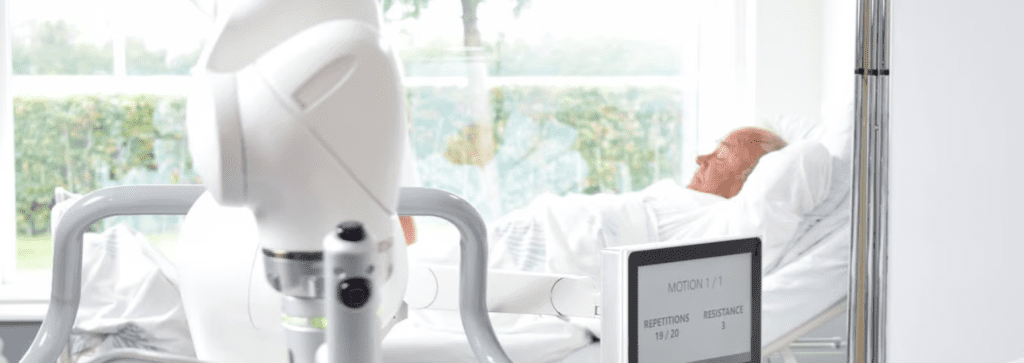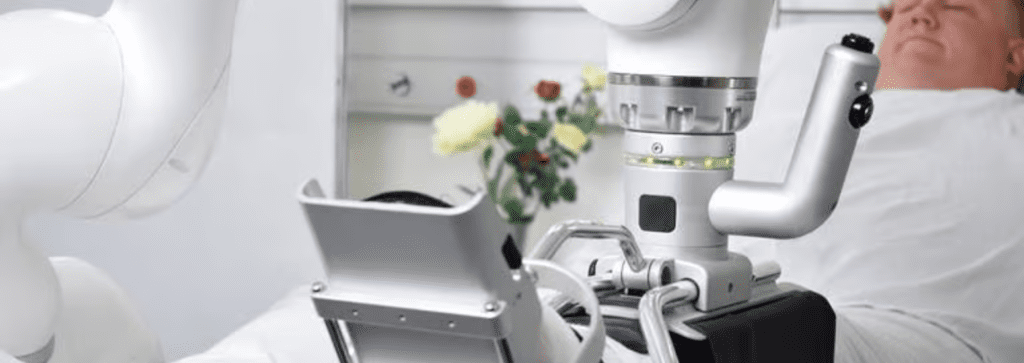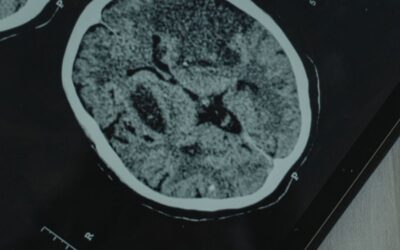Rehabilitation robots in physical therapy with ROBERT®’ is hard work as it is highly intensive. The Robot provides patients and healthcare professionals with better conditions for rehabilitation. The robot offers both active resistive and assistive mobilisation, and provides patients and healthcare professionals with better conditions for recovery.
Robot-assisted therapy in stroke rehabilitation can deliver high-dosage and high-intensity training, making it useful for patients with motor disorders caused by stroke or spinal cord disease. Robotic devices used for motor rehabilitation include lower limb exoskeleton types.
Uses of Robot-assisted therapy in stroke rehabilitation
It’s important we begin rehabilitation exercises, to quickly get patients out of bed!
After surgery or after a stroke, it is often beneficial from a medical perspective to move the patient’s joints and muscles intensively over a sustained period in order to improve healing. If this mobilisation does not take place, complications may arise, such as restricted mobility at a later stage.
Robotic Treatment

How can ROBERT® make a difference for patients, healthcare professionals & institutions
Healthcare Professionals
Reduce heavy and repetitive lifts
- Free resources for other aspects of treatment
- Easy manouvering and simple interface
Patients
Enhance early mobilisation and improve the effectiveness of treatment
- Prevent soft tissue contracture and pressure sores
- Minimise risk of blood clots and pneumonia
- Reduce muscular atrophy and neuropathic effects
Medical Centres
Provide intensive treatment without increasing staff costs
- Faster recovery and return to daily living
- Shorter hospitalisation periods
Rehabilitation Robot

ROBERT® – The Rehabilitation Robots in physical therapy mobilise patients by providing sufficient, personalised training,
Robot-assisted therapy in stroke rehabilitation can also provide a level of patient engagement during repetitive physical tasks that may be difficult to achieve during conventional exercise therapy.
The Robot – ROBERT® provides advanced neuro-robotic rehabilitation technologies for the well-being of patients around the world. ROBERT® is practically designed for easy movements from one room to another. So the patient can remain in bed and focus on the therapy.
It’s important to begin rehabilitation as early as day one of the patient’s hospitalisation even though the patient may be incapable of getting out of bed on their own. While the rehabilitation is intensified, the healthcare professionals are relieved from repeated heavy lifting.
The therapy starts with – the Robot performing a safety test.
The brace is attached to the patient’s lower leg and Robert is rolled up to the bedside, positioned on the patient’s legs. Robert is now ready to perform the therapy.
The patient receives optimal quality training. This will improve patients’ training by the time they leave the intensive care unit.
Once the Robot has been instructed by the healthcare professionals to carry out a training exercise, it operates the heavy and repeated lifting during rehabilitation and thus improves the working environment for the physiotherapist to help the patient.
Rehabilitation robots in physical therapy provide patients and healthcare professionals with better conditions for rehabilitation. ROBERT® supports the rehabilitation of immobilised patients
Connect with ROBERT® at https://rehabmodalities.com/ for a free demo.



